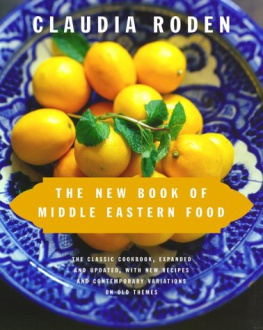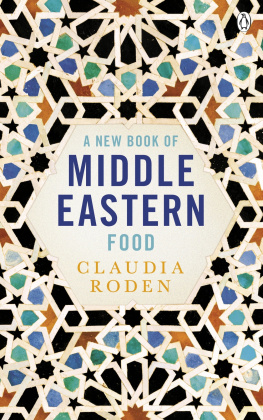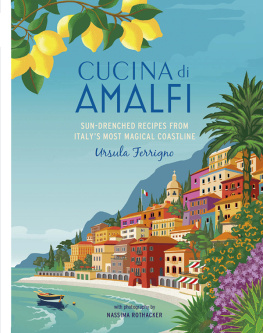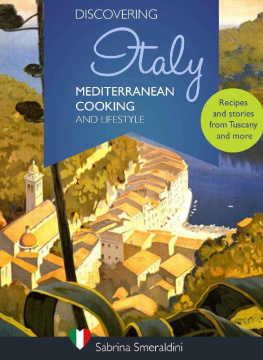CONTENTS
LIST OF RECIPES
For Simon, Nadia and Anna and for the Italian appassionati di cucina who helped me with this book.
This ebook is copyright material and must not be copied, reproduced, transferred, distributed, leased, licensed or publicly performed or used in any way except as specifically permitted in writing by the publishers, as allowed under the terms and conditions under which it was purchased or as strictly permitted by applicable copyright law. Any unauthorized distribution or use of this text may be a direct infringement of the authors and publishers rights and those responsible may be liable in law accordingly.
Version 1.0
Epub ISBN 9781409015499
www.randomhouse.co.uk
Published by Square Peg 2014
10 9 8 7 6 5 4 3 2 1
Copyright Claudia Roden 2014
Claudia Roden has asserted her right under the Copyright, Designs and Patents Act 1988 to be identified as the author of this work.
First published in Great Britain by Chatto & Windus Ltd in 1989
Random House, 20 Vauxhall Bridge Road,
London SW1V 2SA
www.vintage-books.co.uk
Addresses for companies within The Random House Group Limited can be found at:
www.randomhouse.co.uk/offices.htm
The Random House Group Limited Reg. No. 954009
A CIP catalogue record for this book is available from the British Library
ISBN 978 0 22 409601 0
Food styling by Joe Woodhouse
Photographs ; Trulli House, Selva Di Fasano De Agostini
INTRODUCTION
Travelling up and down the country through every corner of Italy almost thirty years ago to research the Taste of Italy series for the Sunday Times Magazine was an undreamt-of opportunity to get to know the food and the country in an intimate kind of way. This 25th anniversary edition of the book that followed has given me the chance to add many new recipes and to update some of the old ones. I wanted to do so because so much has changed in Britain and in Italy in the way we cook and eat.
When the Sunday Times Magazine asked me to write a series on the regional foods of Italy they said they believed it would be the next big thing after French cuisine. At that time Italian restaurants in Britain offered a standard menu of spaghetti, pizza and a few, always the same, dishes. Even in Italy it was not easy to find local regional foods in restaurants. Catering schools there taught classic French cuisine and a few internationally-known Italian dishes, while top restaurants were doing an Italian nouvelle cuisine that meant risotto tricolore with kiwi and strawberries, and calfs liver with mangoes. The magazine series had a huge impact in Britain. Many chefs who opened new Italian restaurants serving regional dishes told me they were inspired by it and by the book that grew out of it.
Italian food has become the most popular food in Britain. You can now find a variety of Italian cured meats and cheeses, great Italian wines and almost any Italian product in specialist shops or online. The clearest demonstration of the real revolution in our tastes is that supermarkets now stock wide ranges of regional Italian products including breads such as the Ligurian focaccia and ciabatta , the Sardinian carta di musica , and Pugliese loaves; regional varieties of dried pasta such as orecchiette from Apulia and trofie from Liguria; stuffed pasta with special fillings, and different varieties of risotto rice. Some ingredients such as the grain called faro (similar to spelt) and burrata, the ball of mozzarella filled with cream, that were hardly available even in Italy are now fashionable here, not to mention balsamic vinegar that went on to conquer the world.
Going over the original recipes, I incorporated products we can now use to make cooking easier such as instant polenta, sheets of lasagne that dont need pre-boiling, sachets of black squid ink, and good-quality frozen chestnuts and artichokes. I could not resist adding a newly discovered variation or improving on a recipe with a new simpler or lighter technique. The selection reflects what is popular in Italy now and how people there cook today. Women work and have less time to cook, and families have few children, often only one. The times when mamma spent a day in the kitchen making pasta are over, but people still have time for food, come home at lunchtime if they can, sit round the table and are passionately fond of their own cooking. They make easy things, put together salads, make pasta rather than risotti which take longer, and buy their tortelli and ravioli.
Another major change in Italy is that for the first time the chain of transmission of culinary knowledge between generations has broken. People no longer learn how to cook from their mothers alone, they learn more from television and the internet, and young men think it is glamorous to cook. The dishes that go the rounds are not fusion or exotic they are traditional, sometimes updated, regional dishes. Bloggers often say that it is their grandmothers recipe and may even put a photo or a video of their grandmother cooking.
When I travelled around Italy years ago people never seemed to know recipes from other regions (they didnt holiday in other regions). Now they are happy to cook them, especially if they are fashionable. The fashionable foods are mostly poor rustic or working mens foods like bean soups and polenta, those based on bread or chestnuts, and spaghetti with cheese and pepper, or with oil, garlic and chilli. Olive oil is more popular than cream and butter as a dressing for pasta, and some now put dried chilli flakes ( peperoncino ) a southern habit, into most things. Regional foods have become national and are more popular than ever.
People are concerned with health and dieting and try to cook lightly, but they still rave about lardo (thin strips of cured pork back fat) which they eat as an antipasto; and eat fritto misto when they are out. There are vegetarians and vegans, and while many now in Italy can only afford to eat cheap mass-produced industrial food, a middle-class elite values the quality and purity of local products.
Years ago I spent a lot of time in restaurant kitchens, watching and taking notes. I sometimes met young American and Japanese cooks working there for free, to learn. Now I can see the legacies they have left behind. While Tokyo is now the city outside Italy with the most Italian restaurants, Italians have come to love sushi and Italian chefs have learnt from the Japanese how to present food in an exquisite manner. From the young Americans, Italians learnt to be creative, with pizzas for instance. But the new pizzas are not American, the toppings are inspired by regional styles there is pizza carbonara , pizza arrabbiata , pizza capricciosa . And fashionable bars started serving inventive crostini and bruschette topped with regional products and traditional combinations, and many people do the same at home.
Ten years ago chefs and food writers were enthralled with the experimentation and invention that was going on in Catalonia and the Basque Country, but more recently there has been a movement away from the excessive use of science and technology. They are now lyrical about their terroir and local products and say that they are merely the conductors of an orchestra where the musicians are the fishermen, farmers and artisans. Suffering from the current economic crisis, and in response to culinary globalization, restaurants have closed in on themselves and offer traditional dishes. Some have managed to turn these into a refined haute cuisine .











![Claudia Roden - Claudia Rodens Mediterranean: Treasured Recipes from a Lifetime of Travel [A Cookbook]](/uploads/posts/book/289768/thumbs/claudia-roden-claudia-roden-s-mediterranean.jpg)




